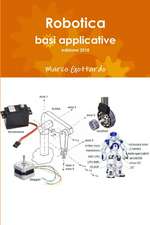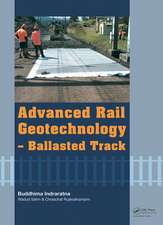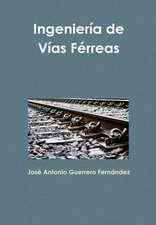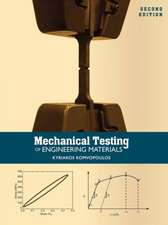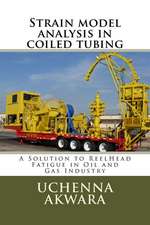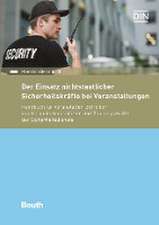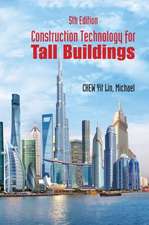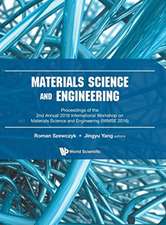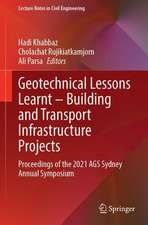Advanced Rail Geotechnology – Ballasted Track
Autor Buddhima Indraratna, Cholachat Rujikiatkamjorn, Wadud Salimen Limba Engleză Hardback – 14 aug 2023
In this book, the authors present the detailed information on the strength, deformation, and degradation aspects of fresh and recycled ballast under monotonic, cyclic, and impact loading using innovative geotechnical testing devices. A constitutive model for ballast incorporating particle breakage is presented representing a more realistic stress–strain response. The mathematical formulations and numerical models are validated using controlled experimental simulations and fully instrumented field trials. Revised ballast gradation is described to provide greater track resiliency and extended longevity. The book also provides a detailed description of geosynthetics for substructure improvement considering track deterioration caused by particle degradation, fouling, and impeded drainage. New to this second edition are extensive discussions on subgrade soil stabilisation, causes and mechanisms of soil fluidisation (mud pumping) under cyclic loading, and preventive and remedial measures to alleviate undue instability of ballast tracks.
This book should prove most beneficial for final-year civil engineering students and for postgraduate teaching and learning. It is an ideal supplement for practising railway engineers and researchers engaged in the challenging tasks of future track design for heavier and faster trains.
Preț: 1346.72 lei
Preț vechi: 1642.35 lei
-18% Nou
Puncte Express: 2020
Preț estimativ în valută:
257.70€ • 269.60$ • 214.07£
257.70€ • 269.60$ • 214.07£
Carte tipărită la comandă
Livrare economică 02-16 aprilie
Preluare comenzi: 021 569.72.76
Specificații
ISBN-13: 9781032244914
ISBN-10: 1032244917
Pagini: 466
Ilustrații: 47 Tables, black and white; 251 Line drawings, black and white; 90 Halftones, black and white; 98 Illustrations, color; 243 Illustrations, black and white
Dimensiuni: 174 x 246 x 25 mm
Greutate: 1.02 kg
Ediția:2nd edition
Editura: CRC Press
Colecția CRC Press
ISBN-10: 1032244917
Pagini: 466
Ilustrații: 47 Tables, black and white; 251 Line drawings, black and white; 90 Halftones, black and white; 98 Illustrations, color; 243 Illustrations, black and white
Dimensiuni: 174 x 246 x 25 mm
Greutate: 1.02 kg
Ediția:2nd edition
Editura: CRC Press
Colecția CRC Press
Public țintă
Postgraduate and ProfessionalRecenzii
"The book is a compendium of knowledge and a milestone in the subject. It will be of significant interest and use to practising engineers and researchers in railway geotechnology alike – a worthwhile investment that I unreservedly recommend."
Prof. William Powrie
Prof. William Powrie
Cuprins
1 Introduction; 2 Track structure and rail load; 3 Factors governing ballast behaviour; 4 State-of-the-art laboratory testing and degradation assessment of ballast; 5 Behaviour of ballast with and without geosynthetics and energy-absorbing mats; 6 Existing track deformation models; 7 A constitutive model for ballast; 8 Track drainage and use of geotextiles; 9 Role of subballast, its drainage, and filtration characteristics; 10 Field instrumentation for track performance verification; 11 Discrete element modelling (DEM) of ballast densification and breakage; 12 Finite element modelling (FEM) of tracks and applications to case studies; 13 Non-destructive testing and track condition assessment; 14 Track maintenance; 15 Recommended ballast gradations; 16 Bioengineering for track stabilisation; 17 Stabilisation of soft subgrade
Notă biografică
Buddhima Indraratna is a Distinguished Professor and Director, Transport Research Centre, University of Technology Sydney (UTS), Australia. His pioneering contributions to geotechnical and railway engineering have been acknowledged through many national and international accolades, such as the 1st Ralph Proctor and 4th Louis Menard Lectures of the International Society of Soil Mechanics and Geotechnical Engineering (ISSMGE), and the award for outstanding individual contributions to railways from the combined Engineers Australia and Railway Technical Society of Australia (RTSA) in 2015. Internationally, his significant contributions are reflected by many awards, for instance, the Thomas Telford Premium by the UK’s Institution of Civil Engineers in 2015, the Medal of Excellence for life-time contributions from the International Association of Computer Methods and Advances in Geomechanics (IACMAG) in 2017, and Robert Quigley commendation awards for his articles published in the Canadian Geotechnical Journal. With 12 books and 950+ publications, he is placed among the most highly cited geotechnical engineers today. He is a Fellow of the prestigious Australian Academy of Technological Sciences and Engineering (FTSE) as well as being a Fellow of other professional organisations such as the Institution of Engineers Australia (FIEAust), the American Society of Civil Engineers (FASCE), and the Geological Society of UK (FGS). He is dedicated to training young professionals having supervised about 70 PhDs and over 40 postdoctoral fellows. For his substantial research outcomes with significant industry impact and long-standing service to the geotechnical fraternity, community, he was recently bestowed the Honorary Life Membership of the Australian Geomechanics Society.
Cholachat Rujikiatkamjorn is a Professor at the Transport Research Centre, School of Civil, and Environmental Engineering, Faculty of Engineering and Information Technology, University of Technology Sydney. He obtained his PhD in Geotechnical Engineering from the University of Wollongong in 2006. He received the Australian Geomechanics Society Thesis Award in 2006. In 2009, he received an award twice from the International Association for Computer Methods and Advances in Geomechanics (IACMAG) for an outstanding paper by an early career researcher, and the 2006 Wollongong Trailblazer Award for innovations in soft soil stabilisation for transport infrastructure. He received the 2012 DH Trollope award and the 2013 ISSMGE Young Member award for academic achievements and outstanding contributions to the field of geotechnical engineering. He secured an early Career Researcher Award through the ARC Centre of Excellence in Geotechnical Science and Engineering with a grant of $680k for 3 years. His key areas of expertise include ground improvement for transport infrastructure and soft soil engineering.
Dr Wadud Salim is a registered professional engineer in Queensland (Australia) with more than 30 years’ experience in the field of geotechnical and civil engineering. He obtained Bachelor of Science in Civil Engineering in 1989, Master of Engineering in 1994, and PhD in 2004. He started his career as a Lecturer in Civil Engineering, then moved to the consulting and construction industry to receive practical experience, returned to research study at the University of Wollongong (Australia) both as a PhD student and as a postdoctoral research fellow, and finally moved to the position of Senior Geotechnical Engineer in the City of Gold Coast, Australia. In his current role, he has carried out geotechnical engineering assessment for thousands of complex development applications and several court cases, which involved very high landslide risk, steep and high cut batters on hill slopes, high retaining walls, soft clay treatments, etc. He published over 20 refereed international conference papers and journal articles. His research interests include rail track geotechnology, slope stability, landslide risk assessment, soft clay stabilisation, and basement excavation stability.
Cholachat Rujikiatkamjorn is a Professor at the Transport Research Centre, School of Civil, and Environmental Engineering, Faculty of Engineering and Information Technology, University of Technology Sydney. He obtained his PhD in Geotechnical Engineering from the University of Wollongong in 2006. He received the Australian Geomechanics Society Thesis Award in 2006. In 2009, he received an award twice from the International Association for Computer Methods and Advances in Geomechanics (IACMAG) for an outstanding paper by an early career researcher, and the 2006 Wollongong Trailblazer Award for innovations in soft soil stabilisation for transport infrastructure. He received the 2012 DH Trollope award and the 2013 ISSMGE Young Member award for academic achievements and outstanding contributions to the field of geotechnical engineering. He secured an early Career Researcher Award through the ARC Centre of Excellence in Geotechnical Science and Engineering with a grant of $680k for 3 years. His key areas of expertise include ground improvement for transport infrastructure and soft soil engineering.
Dr Wadud Salim is a registered professional engineer in Queensland (Australia) with more than 30 years’ experience in the field of geotechnical and civil engineering. He obtained Bachelor of Science in Civil Engineering in 1989, Master of Engineering in 1994, and PhD in 2004. He started his career as a Lecturer in Civil Engineering, then moved to the consulting and construction industry to receive practical experience, returned to research study at the University of Wollongong (Australia) both as a PhD student and as a postdoctoral research fellow, and finally moved to the position of Senior Geotechnical Engineer in the City of Gold Coast, Australia. In his current role, he has carried out geotechnical engineering assessment for thousands of complex development applications and several court cases, which involved very high landslide risk, steep and high cut batters on hill slopes, high retaining walls, soft clay treatments, etc. He published over 20 refereed international conference papers and journal articles. His research interests include rail track geotechnology, slope stability, landslide risk assessment, soft clay stabilisation, and basement excavation stability.
Descriere
Presenting detailed information on strength, deformation, and degradation aspects of fresh and recycled ballast under monotonic, cyclic and impact loading using innovative geotechnical testing devices. A constitutive model for ballast incorporating particle breakage is presented representing a more realistic stress-strain response.


